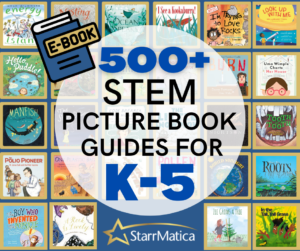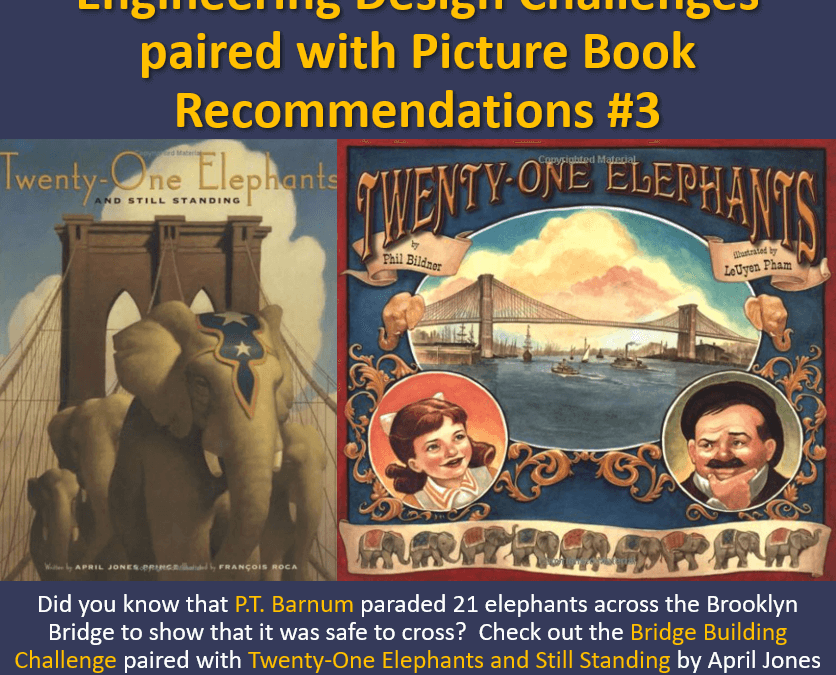Welcome to our third engineering challenge post to help you keep your students engaged the last few weeks of school. (You can find the first two challenges here and here.)
As we shared in the last posts, it is essential to note that these posts are not intended to provide an entire NGSS-aligned lesson plan. My goal is to share resources you can use to design a lesson that meets your specific classroom needs.
Our third challenge is: The Bridge Building Challenge paired with Twenty-One Elephants and Still Standing by April Jones Prince or Twenty-One Elephants by Phil Bildner.
Let me emphasize at the outset that this challenge could go in a myriad of different directions depending on your materials and time constraints. There are many different ways for students to construct their bridges, so I will provide you with some general guidelines and lots of excellent links and ideas.
You could begin your lesson by reading aloud Twenty-One Elephants and Still Standing by April Jones Prince. This beautifully illustrated picture book tells the true story of P.T. Barnum’s stunt to instill confidence in the strength of the Brooklyn Bridge by having his 21 elephants cross it. It is brief and to the point and provides all of the “hook” you need to lead into your bridge-building challenge.
There is another version of this same true story that is told from a young girl’s viewpoint. It is titled: Twenty-One Elephants by Phil Bildner. This second version adds more detail to the story, has more straightforward prose, and gives specific arguments people may have made for why they believed the bridge wasn’t sound. Both texts are good choices.
Questions to Ask While Reading:
The book’s front cover by April Jones Prince is a classic opportunity for your students to break out their predicting skills. Show the cover to your students and ask: What do you notice? What do you wonder? Why do you think this image is on the cover of the book?
If you use the Phil Bildner version, the text is an excellent opportunity to discuss opinions versus facts and evidence. As a class, you can track the reasons (opinions) that people think the bridge isn’t safe and how the little girl refutes each claim with facts and evidence. What a great connection to the Science and Engineering Practice of Engaging in Argument from Evidence!
Whichever book you choose to read, you can discuss with your class why they think P.T. Barnum decided to stage such an elaborate test of the bridge. Why do you think he believed it was safe? What does the text say about one person’s ability to make a difference?
The Challenge:
Challenge your students to design a bridge that will hold a specific amount of weight you determine. That weight could be in a certain number of coins, counting cubes, crayons, or pretty much anything that will fit on their bridges! I highly recommend building your own bridge without the students around and testing what weight makes sense for your constraints. Too much weight and it will be difficult for the students to be successful. Not enough weight, and even the most shakily constructed bridges will stand. (Check out this popsicle stick bridge that held 100 pounds!
You’ll want to carefully consider your time and materials constraints before beginning the project. Also, think about other constraints, such as whether the bridge needs to be a certain length. I love this challenge because it can be adapted to many age levels and completed with many different materials. You could have kindergarteners building with popsicle sticks and paper cups or fifth graders constructing with straws and tape. Here are a few blog posts that share different materials you could use for your bridge construction:
- This post shares a unique construction using an egg carton, markers, rubber bands, and a ruler.
- This post uses toilet paper rolls, paper cups, and popsicle sticks.
- This post uses straws and tape.
- This post uses paper and tape.
I share these posts to show some examples of bridges constructed using different materials; however, there are several issues to keep in mind when viewing the posts above. First, the most important part of this challenge is not to provide your students with templates and examples for what to create. Do not show them a photograph, a model you built, or a template. Your job is to provide your students the supplies and the constraints and then to step back and let them figure out what to build. I can’t stress this enough – your only job is to facilitate by asking questions. And if your students’ bridges end up looking like cookie-cutter copies of each other, you have likely given them too much information upfront and turned your engineering challenge into a craft. (Nothing against crafts, but they just shouldn’t be mistaken for engineering challenges!)
It is also a mistake to give your students too much information at the beginning of the challenge. Resist the temptation to do a mini-lesson about different types of bridges and/or how to create a structurally sound bridge. We want students to be engaged in the activity as engineers who are tasked with figuring out a solution. Once the students have had the opportunity to construct their first structures, come together as a class and discuss what worked well and what didn’t. At this point, you could challenge students to build bridges that will hold even greater weights. And you can start to bring in resources for students to learn how their bridges can be made more structurally sound.
Bridges! Amazing Structures to Design, Build & Test by Carol A Johmann and Elizabeth J. Rieth is a fantastic resource to share with students during this process. The book discusses the process of building a bridge, different bridge engineering concepts, and the structure of different types of bridges. This book should be a resource for students to learn concepts to apply to their own designs. Please resist the temptation to use this book at the beginning of your lesson, or it may be difficult for your students to create bridges that aren’t copies of bridge construction ideas suggested in the book. Once your students have done some research, have them modify and test their designs using the knowledge they have gained.
Two additional picture books to enrich your bridge study are:
Bridges Are To Cross by Philemon Sturges and This Bridge Will Not Be Gray by Dave Eggers. Bridges Are To Cross is a beautiful compilation of illustrations of bridges around the world paired with a brief explanation of why they were built. There are many great opportunities in the text to have conversations about structure and function.
Don’t be deterred by the thickness of This Bridge Will Not Be Gray! The pages aren’t textually dense, and the way the story is told is very engaging. (Even my four-year-old loved listening to it!) The text is a simple introduction to the bridge-building process and gives a unique window into how and why specific decisions are made during construction.
Next Generation Science Standards Connections:
These engineering performance expectations fit well with this challenge:
- K-2-ETS1-2 Develop a simple sketch, drawing, or physical model to illustrate how the shape of an object helps it function as needed to solve a given problem.
- 3-5-ETS1-3 Plan and carry out fair tests in which variables are controlled, and failure points are considered to identify aspects of a model or prototype that can be improved.
This challenge also makes connections with these grade-level PEs:
- 3-PS2-1 Plan and investigate to provide evidence of the effects of balanced and unbalanced forces on the motion of an object.
- 5-PS2-1 Support an argument that the gravitational force exerted by Earth on objects is directed down.
If you are a StarrMatica Texts: Science Your Way subscriber, you can check out the engineering and forces and motion informational texts below. Remember, each 1st – 5th grade text has multiple reading levels, so all of your students can read the same content independently. I recommend having students use these text resources after they have designed and built their bridges. Used this way, the texts help students learn vocabulary and background information they can use to explain what they have learned on their own.
- 5th Grade: Gravity’s Forceful Nature
- 3rd Grade: May The Force Be With You
- 3rd-5th Engineering: Watering Your Garden on Vacation
- 3rd-5th Engineering: Two Ways to Solve a Problem
- 3rd-5th Engineering: Testing Prototypes
- K-2nd Engineering: All About Bridges
- K-2nd Engineering: Be The Engineer
Not a subscriber? Click here for a free trial to access the texts above.
Structure and function is the central crosscutting concept that fits well with this challenge.
And students are using nearly all of the science and engineering practices. They are developing and using models as they construct their bridges. Students are planning and carrying out investigations as they test the amount of weight their bridge can hold. They construct explanations and design solutions when determining why a bridge has failed and deciding how to fix it. When they share their structures with peers, they are obtaining, evaluating, and communicating information. There are many possibilities for incorporating analyzing and interpreting data in upper elementary and using mathematics and computational thinking. For example, if a bridge with a single layer of popsicle sticks can hold X amount of weight, how much weight should a double layer of popsicle sticks be able to hold? Why?
Bottom line: Step out of the way and have fun seeing what bridge designs your students can construct
 Are you are looking for additional picture books for your science classroom, check out the Perfect Picture Book Pairing Series that includes one-page guides with activities and discussion questions for hundreds of STEM-themed picture books aligned to every NGSS performance expectation!
Are you are looking for additional picture books for your science classroom, check out the Perfect Picture Book Pairing Series that includes one-page guides with activities and discussion questions for hundreds of STEM-themed picture books aligned to every NGSS performance expectation!
CLICK HERE TO PREVIEW THE PERFECT PICTURE BOOK PAIRING EBOOKS

